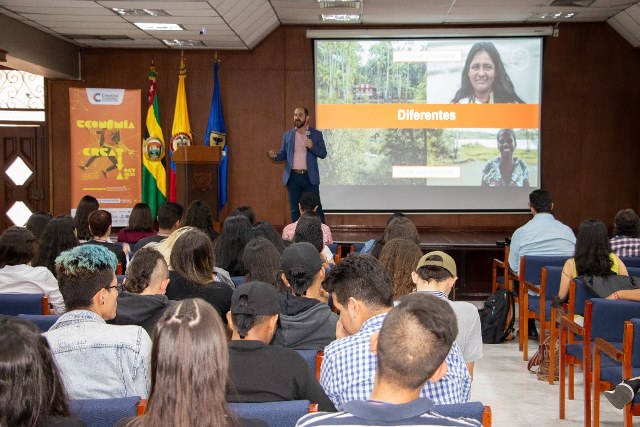LA UDES PUBLICA
- Fecha de publicación:
- 2025-01-01
- Tipo:
- Article
- Identificación:
- SCOPUS_ID:105014811674
- eID:
- 2-s2.0-105014811674
- Nombre de la revista:
- Community Mental Health Journal
- Autor(es) UDES:
- Acuña-Mejía P.A.
- Otros Autores:
- Agudelo-Hernández F., Mejía-Chaves M., Plata-Casas L.I., Cuadrado L.
- Autor Principal:
- Agudelo-Hernández F.
- Áreas del conocimiento:
- Health (social science), Public Health, Environmental and Occupational Health, Psychiatry and Mental Health
- Tipo
- Journal
- ISSN
- 00103853
- eISSN
- 15732789
- Fecha de publicación:
- 2025-09-01
- Tipo:
- Review
- Identificación:
- SCOPUS_ID:105014891637
- eID:
- 2-s2.0-105014891637
- Nombre de la revista:
- Salud Uninorte
- Autor(es) UDES:
- Rincón-Rueda Z.R., Buitrago-Buitrago J.A., Uribe-Calderón L.M.
- Autor Principal:
- Rincón-Rueda Z.R.
- Áreas del conocimiento:
- Medicine (all)
- Tipo
- Journal
- ISSN
- 01205552
- eISSN
- 20117531
- Volumen
- 41
- Rango de páginas
- 964-979
- Fecha de publicación:
- 2025-01-01
- Tipo:
- Conference Paper
- Número de artículo:
- V006T11A069
- Identificación:
- SCOPUS_ID:105015295439
- eID:
- 2-s2.0-105015295439
- Nombre de la revista:
- Proceedings of the International Conference on Offshore Mechanics and Arctic Engineering OMAE
- Autor(es) UDES:
- Rivera F.P., Lopez I.O.
- Otros Autores:
- Rodriguez F., Morales R., Belhaj H., Belhaj A.
- Autor Principal:
- Rodriguez F.
- Áreas del conocimiento:
- Ocean Engineering, Energy Engineering and Power Technology, Mechanical Engineering
- Tipo
- Conference Proceeding
- Volumen
- 6
- Fecha de publicación:
- 2025-01-01
- Tipo:
- Conference Paper
- Número de artículo:
- V006T11A063
- Identificación:
- SCOPUS_ID:105015295114
- eID:
- 2-s2.0-105015295114
- Nombre de la revista:
- Proceedings of the International Conference on Offshore Mechanics and Arctic Engineering OMAE
- Autor(es) UDES:
- Rivera F.P., Lopez I.O.
- Otros Autores:
- Rodriguez F., Morales R., Belhaj H., Belhaj A.
- Autor Principal:
- Rodriguez F.
- Áreas del conocimiento:
- Ocean Engineering, Energy Engineering and Power Technology, Mechanical Engineering
- Tipo
- Conference Proceeding
- Volumen
- 6
- Fecha de publicación:
- 2025-12-01
- Tipo:
- Article
- Número de artículo:
- 32401
- Identificación:
- SCOPUS_ID:105015449188
- eID:
- 2-s2.0-105015449188
- Nombre de la revista:
- Scientific Reports
- Autor(es) UDES:
- Gutiérrez J.D.
- Otros Autores:
- Bravo-Vega C., Cordovez J.M.
- Autor Principal:
- Gutiérrez J.D.
- Áreas del conocimiento:
- Multidisciplinary
Cuartil
Q1
- Ranking
- 4401
- Tipo
- Journal
- eISSN
- 20452322
- Región
- Western Europe
- País
- United Kingdom
- Volumen
- 15
- Cobertura
- 2011-2022
- Fecha de publicación:
- 2025-10-30
- Tipo:
- Article
- Número de artículo:
- 138236
- Identificación:
- SCOPUS_ID:105015358073
- eID:
- 2-s2.0-105015358073
- Nombre de la revista:
- Energy
- Autor(es) UDES:
- Joya-Cárdenas D.R., Delgado Monroy J.
- Otros Autores:
- Barco Burgos J., Bruno J.C., Ganesan A., Cimmino L., Garcia-G D., Saldaña-Robles A., Colombo J., Ortiz Valdez C.I.
- Autor Principal:
- Barco Burgos J.
- Áreas del conocimiento:
- Civil and Structural Engineering, Building and Construction, Modeling and Simulation, Renewable Energy, Sustainability and the Environment, Fuel Technology, Energy Engineering and Power Technology, Pollution, Mechanical Engineering, Energy (all), Industrial and Manufacturing Engineering, Management, Monitoring, Policy and Law, Electrical and Electronic Engineering
- Tipo
- Journal
- ISSN
- 03605442
- eISSN
- 18736785
- Volumen
- 335
- Fecha de publicación:
- 2025-09-02
- Tipo:
- Article
- Identificación:
- SCOPUS_ID:105015649879
- eID:
- 2-s2.0-105015649879
- Nombre de la revista:
- Lipids in Health and Disease
- Autor(es) UDES:
- Lopez-Lopez J.P.
- Otros Autores:
- Cordoba-Melo B.D., Seni-Molina S., Arango-Ibanez J.P., Ayala M.R., Tatis-Méndez J.F., Quintero Yepez V., Mejía Cadavid L.A., Cruz-Cuevas J.D., Ariza-Ordóñez N., Buitrago A., Hinestrosa A., Sabogal J., Reyes-Vargas C., Herrera-Escandon Á., Hurtado J.S., Velásquez Osorio J.F., Londoño S., Salamanca C., Vallecilla L., Leon-Giraldo H., Ruiz A.J., Molina D.I., Gomez-Mesa J.E.
- Autor Principal:
- Cordoba-Melo B.D.
- Áreas del conocimiento:
- Endocrinology, Diabetes and Metabolism, Endocrinology, Clinical Biochemistry, Biochemistry (medical)
Cuartil
Q1
- Ranking
- 3946
- Tipo
- Journal
- eISSN
- 1476511X
- Región
- Western Europe
- País
- United Kingdom
- Volumen
- 24
- Rango de páginas
- 275
- Cobertura
- 2002-2022
- Fecha de publicación:
- 2025-09-01
- Tipo:
- Review
- Identificación:
- SCOPUS_ID:105015973370
- eID:
- 2-s2.0-105015973370
- Nombre de la revista:
- Revista Facultad Nacional De Agronomia Medellin
- Autor(es) UDES:
- Rodríguez Villamizar M.Y.
- Otros Autores:
- Sanabria Ospino A.E., Contreras Gómez A.E.Y.
- Autor Principal:
- Sanabria Ospino A.E.
- Áreas del conocimiento:
- Forestry, Food Science, Animal Science and Zoology, Agronomy and Crop Science, Agricultural and Biological Sciences (miscellaneous), Horticulture
Cuartil
Q3
- Ranking
- 17405
- Tipo
- Journal
- ISSN
- 03042847
- eISSN
- 22487026
- Región
- Latin America
- País
- Colombia
- Volumen
- 78
- Rango de páginas
- 11267-11284
- Cobertura
- 2016-2022
- Fecha de publicación:
- 2025-05-09
- Tipo:
- Article
- Identificación:
- SCOPUS_ID:105016609675
- eID:
- 2-s2.0-105016609675
- Nombre de la revista:
- International Journal of Education and Practice
- Autor(es) UDES:
- Monsalve D.B.
- Otros Autores:
- Baquero J.E.G.
- Autor Principal:
- Baquero J.E.G.
- Áreas del conocimiento:
- Education, Developmental and Educational Psychology
Cuartil
Q3
- Ranking
- 17347
- Tipo
- Journal
- ISSN
- 23116897
- eISSN
- 23103868
- Región
- Northern America
- País
- United States
- Volumen
- 13
- Rango de páginas
- 1167-1181
- Cobertura
- 2018-2022
- Fecha de publicación:
- 2025-02-25
- Tipo:
- Article
- Número de artículo:
- e-v7n2a431
- Identificación:
- SCOPUS_ID:105016752014
- eID:
- 2-s2.0-105016752014
- Nombre de la revista:
- Revista De Investigacion E Innovacion En Ciencias De La Salud
- Autor(es) UDES:
- Martínez-Vega R.A.
- Otros Autores:
- Mantilla Parada G., Pino Navarro H., Rincón-Orozco B.
- Autor Principal:
- Mantilla Parada G.
- Áreas del conocimiento:
- Health Professions (miscellaneous), Physical Therapy, Sports Therapy and Rehabilitation, Occupational Therapy, Public Health, Environmental and Occupational Health, Speech and Hearing
- Ranking
- 27925
- Tipo
- Journal
- eISSN
- 26652056
- Región
- Latin America
- País
- Colombia
- Volumen
- 7
- Cobertura
- 2022
- Fecha de publicación:
- 2025-01-01
- Tipo:
- Review
- Identificación:
- SCOPUS_ID:105016885893
- eID:
- 2-s2.0-105016885893
- Nombre de la revista:
- Clinical Endocrinology
- Autor(es) UDES:
- Sánchez-Delgado J.C., Jácome-Hortúa A.M.
- Otros Autores:
- Bernal J.V.M., Couto N.M.d.S., Ribeiro V.B., Melo K.Y.d., Ferreira L.D., Macedo A.B.O.D.d., Souza H.C.D.d.
- Autor Principal:
- Bernal J.V.M.
- Áreas del conocimiento:
- Endocrinology, Diabetes and Metabolism, Endocrinology
- Tipo
- Journal
- ISSN
- 03000664
- eISSN
- 13652265
- Fecha de publicación:
- 2025-09-14
- Tipo:
- Note
- Identificación:
- SCOPUS_ID:105017169062
- eID:
- 2-s2.0-105017169062
- Nombre de la revista:
- Gaceta Medica De Caracas
- Autor(es) UDES:
- Navas J.A.H., León J.S.T.
- Otros Autores:
- Sarmiento L.A.D., Ayala J.A.G., Beltran Y.J.V.
- Autor Principal:
- Navas J.A.H.
- Áreas del conocimiento:
- Medicine (all)
Cuartil
Q4
- Ranking
- 24475
- Tipo
- Journal
- ISSN
- 03674762
- eISSN
- 27390012
- Región
- Latin America
- País
- Venezuela
- Volumen
- 133
- Rango de páginas
- 663-665
- Cobertura
- 1954-1957, 1959-1965, 1971-1976, 1978-1988, 2008-2014, 2017-2022
- Fecha de publicación:
- 2025-09-14
- Tipo:
- Letter
- Identificación:
- SCOPUS_ID:105017129330
- eID:
- 2-s2.0-105017129330
- Nombre de la revista:
- Gaceta Medica De Caracas
- Autor(es) UDES:
- Hernández Navas J.A.
- Otros Autores:
- Dulcey Sarmiento L.A., Therán León J.S., Gómez Ayala J.A., Villamizar Beltrán Y.J.
- Autor Principal:
- Hernández Navas J.A.
- Áreas del conocimiento:
- Medicine (all)
Cuartil
Q4
- Ranking
- 24475
- Tipo
- Journal
- ISSN
- 03674762
- eISSN
- 27390012
- Región
- Latin America
- País
- Venezuela
- Volumen
- 133
- Rango de páginas
- 661-662
- Cobertura
- 1954-1957, 1959-1965, 1971-1976, 1978-1988, 2008-2014, 2017-2022
- Fecha de publicación:
- 2025-08-01
- Tipo:
- Article
- Identificación:
- SCOPUS_ID:105017154203
- eID:
- 2-s2.0-105017154203
- Nombre de la revista:
- European Heart Journal Supplement
- Autor(es) UDES:
- Lopez-Lopez J.P., Otero J., Lopez-Jaramillo P.
- Otros Autores:
- Urbina Z., Sanchez-Vallejo G., Narvaez C., Camacho P.A., Urina-Triana M., Quintero A., Aroca G., Campo A., Arcos E., Perez-Mayorga M., Mosquera W., Garcia L., Beaney T., Kerr G., Poulter N.R.
- Autor Principal:
- Lopez-Lopez J.P.
- Áreas del conocimiento:
- Cardiology and Cardiovascular Medicine
Cuartil
Q3
- Ranking
- 11107
- Tipo
- Journal
- ISSN
- 1520765X
- eISSN
- 15542815
- Región
- Western Europe
- País
- United Kingdom
- Volumen
- 27
- Rango de páginas
- vii23-vii26
- Cobertura
- 1999-2012, 2014-2022
- Fecha de publicación:
- 2025-01-31
- Tipo:
- Article
- Número de artículo:
- e5057
- Identificación:
- SCOPUS_ID:105017503532
- eID:
- 2-s2.0-105017503532
- Nombre de la revista:
- Innovaciencia
- Autor(es) UDES:
- Amaya-Diaz L.P.
- Otros Autores:
- Ramoni-Perazzi J., Orlandoni-Merli G.
- Autor Principal:
- Ramoni-Perazzi J.
- Áreas del conocimiento:
- Chemistry (miscellaneous), Agricultural and Biological Sciences (miscellaneous)
- Tipo
- Journal
- eISSN
- 2346075X
- Volumen
- 13
- Fecha de publicación:
- 2025-09-29
- Tipo:
- Article
- Identificación:
- SCOPUS_ID:105018101462
- eID:
- 2-s2.0-105018101462
- Nombre de la revista:
- Investigacion En Educacion Medica
- Autor(es) UDES:
- Bravo-Gómez M.A., Amaya-Diaz L.P., Arteagamedina J., Rivera-Carvajal R., Cardozo-Arias M.X.
- Autor Principal:
- Bravo-Gómez M.A.
- Áreas del conocimiento:
- Health (social science), Medicine (miscellaneous), Education, Health Professions (all), Health Informatics
- Tipo
- Journal
- ISSN
- 2007865X
- eISSN
- 20075057
- Volumen
- 14
- Rango de páginas
- 94-104
- Fecha de publicación:
- 2025-01-01
- Tipo:
- Erratum
- Número de artículo:
- 1701519
- Identificación:
- SCOPUS_ID:105018043300
- eID:
- 2-s2.0-105018043300
- Nombre de la revista:
- Frontiers in Pediatrics
- Autor(es) UDES:
- Cuadros Mendoza C.A., Rosero Portilla M.J., Pico Quintero V.
- Otros Autores:
- Manrique-Hernández E.F., Hurtado-Ortiz A., Licht-Ardila M., Mendoza-Monsalve A.
- Autor Principal:
- Cuadros Mendoza C.A.
- Áreas del conocimiento:
- Pediatrics, Perinatology and Child Health
Cuartil
Q1
- Ranking
- 5997
- Tipo
- Journal
- eISSN
- 22962360
- Región
- Western Europe
- País
- Switzerland
- Volumen
- 13
- Cobertura
- 2013-2022
- Fecha de publicación:
- 2025-01-01
- Tipo:
- Article
- Número de artículo:
- 837
- Identificación:
- SCOPUS_ID:105018117354
- eID:
- 2-s2.0-105018117354
- Nombre de la revista:
- Data and Metadata
- Autor(es) UDES:
- Del Castillo A.S.M., Murillo G.P.T., Losada J.C.S.
- Otros Autores:
- Rivadeneira D.X.R., Toledo J.A.J.
- Autor Principal:
- Del Castillo A.S.M.
- Áreas del conocimiento:
- Computer Science (miscellaneous), Information Systems, Information Systems and Management, Health Information Management
- Tipo
- Journal
- eISSN
- 29534917
- Volumen
- 4
- Fecha de publicación:
- 2025-10-08
- Tipo:
- Article
- Identificación:
- SCOPUS_ID:105018279699
- eID:
- 2-s2.0-105018279699
- Nombre de la revista:
- Histochemistry and Cell Biology
- Autor(es) UDES:
- Silva-Sayago J.A.
- Otros Autores:
- Bautista-Amorocho H.
- Autor Principal:
- Bautista-Amorocho H.
- Áreas del conocimiento:
- Histology, Molecular Biology, Medical Laboratory Technology, Cell Biology
- Tipo
- Journal
- eISSN
- 1432119X
- Volumen
- 163
- Rango de páginas
- 96
- Fecha de publicación:
- 2025-01-01
- Tipo:
- Article
- Identificación:
- SCOPUS_ID:105018275762
- eID:
- 2-s2.0-105018275762
- Nombre de la revista:
- Plos One
- Autor(es) UDES:
- Farfán-García A.E., Hernández-Peñaranda I.P., Rincón-Barón E.J., Flórez-Castillo J.M.
- Otros Autores:
- Gómez-Duarte O.G., Torres-Rodríguez G.A.
- Autor Principal:
- Farfán-García A.E.
- Áreas del conocimiento:
- Multidisciplinary
Cuartil
Q1
- Ranking
- 5108
- Tipo
- Journal
- eISSN
- 19326203
- Región
- Northern America
- País
- United States
- Volumen
- 20
- Rango de páginas
- e0334029
- Cobertura
- 2006-2022
- Fecha de publicación:
- 2025-10-01
- Tipo:
- Article
- Identificación:
- SCOPUS_ID:105018647217
- eID:
- 2-s2.0-105018647217
- Nombre de la revista:
- Plos Neglected Tropical Diseases
- Autor(es) UDES:
- Tapias Rivera J., Martínez-Vega R., Quintero-García W.L., Gutiérrez-Torres J.D.
- Otros Autores:
- Torres-Martínez D.S., Monroy-Díaz A.L., Sánchez-Corrales L.
- Autor Principal:
- Tapias Rivera J.
- Áreas del conocimiento:
- Public Health, Environmental and Occupational Health, Infectious Diseases
- Tipo
- Journal
- eISSN
- 19352735
- Volumen
- 19
- Rango de páginas
- e0013594
- Fecha de publicación:
- 2025-09-30
- Tipo:
- Article
- Identificación:
- SCOPUS_ID:105018489548
- eID:
- 2-s2.0-105018489548
- Nombre de la revista:
- Revista De La Federacion Argentina De Cardiologia
- Autor(es) UDES:
- Navas J.A.H., Therán J.
- Otros Autores:
- Dulcey L., Gómez J.
- Autor Principal:
- Navas J.A.H.
- Áreas del conocimiento:
- Cardiology and Cardiovascular Medicine
- Tipo
- Journal
- ISSN
- 0326646X
- Volumen
- 54
- Rango de páginas
- 197-201
- Fecha de publicación:
- 2025-01-01
- Tipo:
- Article
- Número de artículo:
- 7148191
- Identificación:
- SCOPUS_ID:105018510601
- eID:
- 2-s2.0-105018510601
- Nombre de la revista:
- International Journal of Microbiology
- Autor(es) UDES:
- Morales-Lopez S.
- Otros Autores:
- Villero Wolf Y., Lechuga D., Caicedo L., Acosta Triana Y., Gomez L., Ramirez L.R., Narvaez L., Pinzon H., Esquea K., Barros R., Martinez Ramos P., Marin A., Parra C.M.
- Autor Principal:
- Morales-Lopez S.
- Áreas del conocimiento:
- Microbiology, Ecology, Evolution, Behavior and Systematics, Microbiology (medical)
- Tipo
- Journal
- ISSN
- 1687918X
- eISSN
- 16879198
- Volumen
- 2025
- Fecha de publicación:
- 2025-01-01
- Tipo:
- Article
- Identificación:
- SCOPUS_ID:105018691288
- eID:
- 2-s2.0-105018691288
- Nombre de la revista:
- International Journal of Morphology
- Autor(es) UDES:
- Hurtado-Giraldo H., Rocha-Muñoz L.P., Romero-Osorio N.I., Conde-Ocazionez S., Duque-Díaz E.
- Otros Autores:
- Coveñas R.
- Autor Principal:
- Hurtado-Giraldo H.
- Áreas del conocimiento:
- Anatomy
- Tipo
- Journal
- ISSN
- 07179367
- eISSN
- 07179502
- Volumen
- 43
- Rango de páginas
- 1122-1127
- Fecha de publicación:
- 2026-02-01
- Tipo:
- Article
- Número de artículo:
- 107309
- Identificación:
- SCOPUS_ID:105018854384
- eID:
- 2-s2.0-105018854384
- Nombre de la revista:
- Computers and Operations Research
- Autor(es) UDES:
- Cáceres-Gelvez S.
- Otros Autores:
- Dang T.H., Letchford A.N.
- Autor Principal:
- Cáceres-Gelvez S.
- Áreas del conocimiento:
- Computer Science (all), Modeling and Simulation, Management Science and Operations Research
- Tipo
- Journal
- ISSN
- 03050548
- Volumen
- 186
Bogotá
Cra. 14 N° 80-35
PBX: (+57) (601) 6914004
Línea Directa Interesados Programas: (601) 6914104
Horario de Atención: lunes a viernes de 7:00 a.m - 12:00 m. y de 2:00 p.m a 6:00 p.m
Pregrados
Universidad de Santander UDES. Vigilada Mineducación.
Resolución otorgada por el Ministerio de Educación Nacional: No. 6216 del 22 de diciembre de 2005 / Personería Jurídica 810 de 12/03/96.
Institución sujeta a inspección y vigilancia por el Ministerio de Educación Nacional. Resolución 12220 de 2016.
Notificaciones administrativas y judiciales:
Copyright © 2021 - Todos los derechos reservados




























